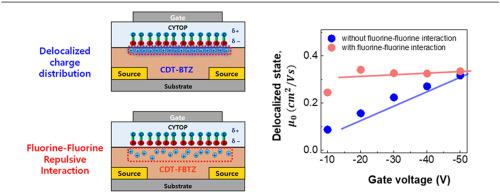Organic Electronics ( IF 2.7 ) Pub Date : 2021-11-26 , DOI: 10.1016/j.orgel.2021.106402 Doyeon Kim 1 , Minho Yoon 1 , Young Tea Chun 2 , Jiyoul Lee 1, 3

|
This study elucidates the effect of fluorine–fluorine interactions on the charge transport properties of semiconductor channels in polymer-based field effect transistors (PFETs) in which both a donor–acceptor (D–A)-type conjugated polymer and a polymer dielectric material contain fluorinated units. The fluorinated units on the benzothiadiazole (BTZ) block of cyclopentadithiophene-alt-benzothiadiazole (CDT-BTZ) allow conformation locking via F⋯S nonbonding interactions, which increases the planarity of cyclopentadithiophene-alt-fluoro-2,1,3-benzothiadiazole (CDT-FBTZ). Thus, the CDT-FBTZ copolymer films are highly crystalline and adopt the edge-on orientation, resulting in an eight-fold increase in the field-effect mobility for CDT-FBTZ-based PFETs coated with a poly(methyl methacrylate) (PMMA) dielectric layer compared with PMMA-coated CDT-BTZ-based PFETs. Meanwhile, the field-effect mobility of CDT-BTZ-based PFETs containing a fluorinated dielectric polymer (CYTOP) is double that of PMMA-coated CDT-BTZ-based PFETs. These enhanced electrical properties are attributed to surface polarization doping at the interface between the conjugated polymer and the fluorinated polymer dielectric. However, despite the effect of surface polarization doping, the electrical properties of CDT-FBTZ-based PFETs deteriorate when combined with the fluorinated CYTOP dielectric. Charge transport analyses based on the Gaussian disorder model reveal that, for CDT-based D–A-type conjugated copolymer PFETs, very few localized states in the semiconducting channel of PFET devices in which fluorine–fluorine interaction effects occur at the interface switch to delocalized states as the gate-bias increases. In contrast, the localized charge states in PFET channels without fluorine–fluorine interactions depend strongly on the applied gate-bias and become delocalized upon applying a gate-bias. Thus, it is inferred that the fluorine–fluorine repulsive coupling in D–A-type conjugated copolymers containing fluorinated functional moieties that interface with fluorinated polymer dielectric layers hinders the delocalization of charges induced by the gate-bias, thereby degrading the device performance.
中文翻译:

氟-氟排斥偶联对环戊二噻吩基供体-受体型共轭共聚物薄膜电荷传输的影响
本研究阐明了氟-氟相互作用对基于聚合物的场效应晶体管 (PFET) 中半导体通道电荷传输特性的影响,其中供体 - 受体 (D-A) 型共轭聚合物和聚合物介电材料均含有氟化单元。cyclopentadithiophene-的苯并噻二唑(BTZ)块上的氟化单元ALT -benzothiadiazole(CDT-BTZ)允许经由˚F⋯分子构象锁定的非键相互作用,这增加cyclopentadithiophene-的平面中高音-氟-2,1,3-苯并噻二唑 (CDT-FBTZ)。因此,CDT-FBTZ 共聚物薄膜是高度结晶的并采用侧向取向,导致涂有聚(甲基丙烯酸甲酯)(PMMA)的基于 CDT-FBTZ 的 PFET 的场效应迁移率增加了八倍介电层与基于 PMMA 涂层的 CDT-BTZ 的 PFET 相比。同时,包含氟化介电聚合物 (CYTOP) 的 CDT-BTZ 基 PFET 的场效应迁移率是 PMMA 涂层 CDT-BTZ 基 PFET 的两倍。这些增强的电性能归因于共轭聚合物和氟化聚合物电介质之间界面处的表面极化掺杂。然而,尽管存在表面极化掺杂的影响,但当与氟化 CYTOP 电介质结合时,基于 CDT-FBTZ 的 PFET 的电性能会恶化。基于高斯无序模型的电荷传输分析表明,对于基于 CDT 的 D-A 型共轭共聚物 PFET,PFET 器件的半导体沟道中的局域态很少,其中氟 - 氟相互作用效应发生在界面切换到离域状态随着栅极偏置的增加。相比之下,没有氟 - 氟相互作用的 PFET 通道中的局部电荷态强烈依赖于施加的栅极偏置,并在施加栅极偏置时变得离域。因此,推测含有与氟化聚合物介电层交界的氟化功能部分的 D-A 型共轭共聚物中的氟 - 氟排斥耦合阻碍了由栅极偏置引起的电荷的离域化,从而降低了器件性能。
















































 京公网安备 11010802027423号
京公网安备 11010802027423号